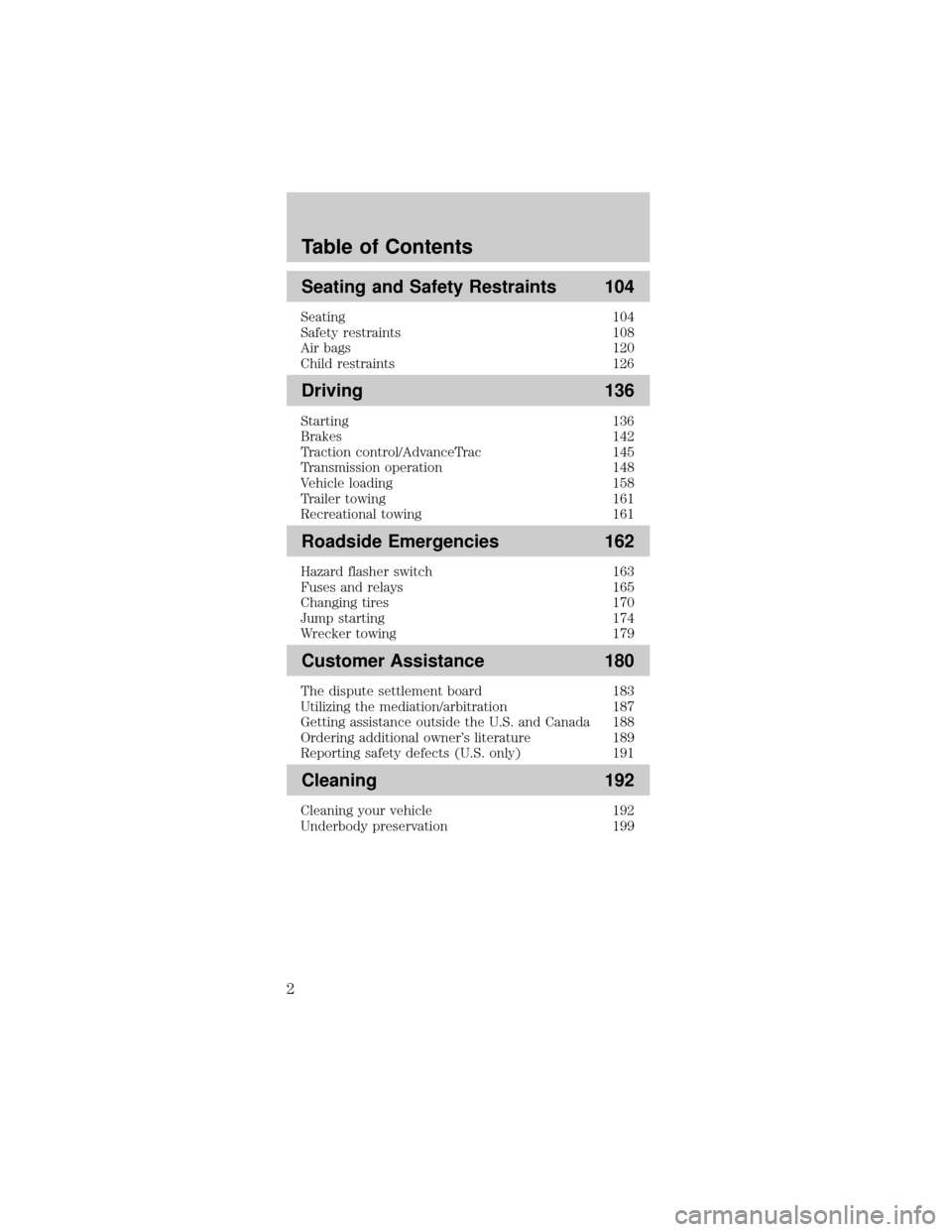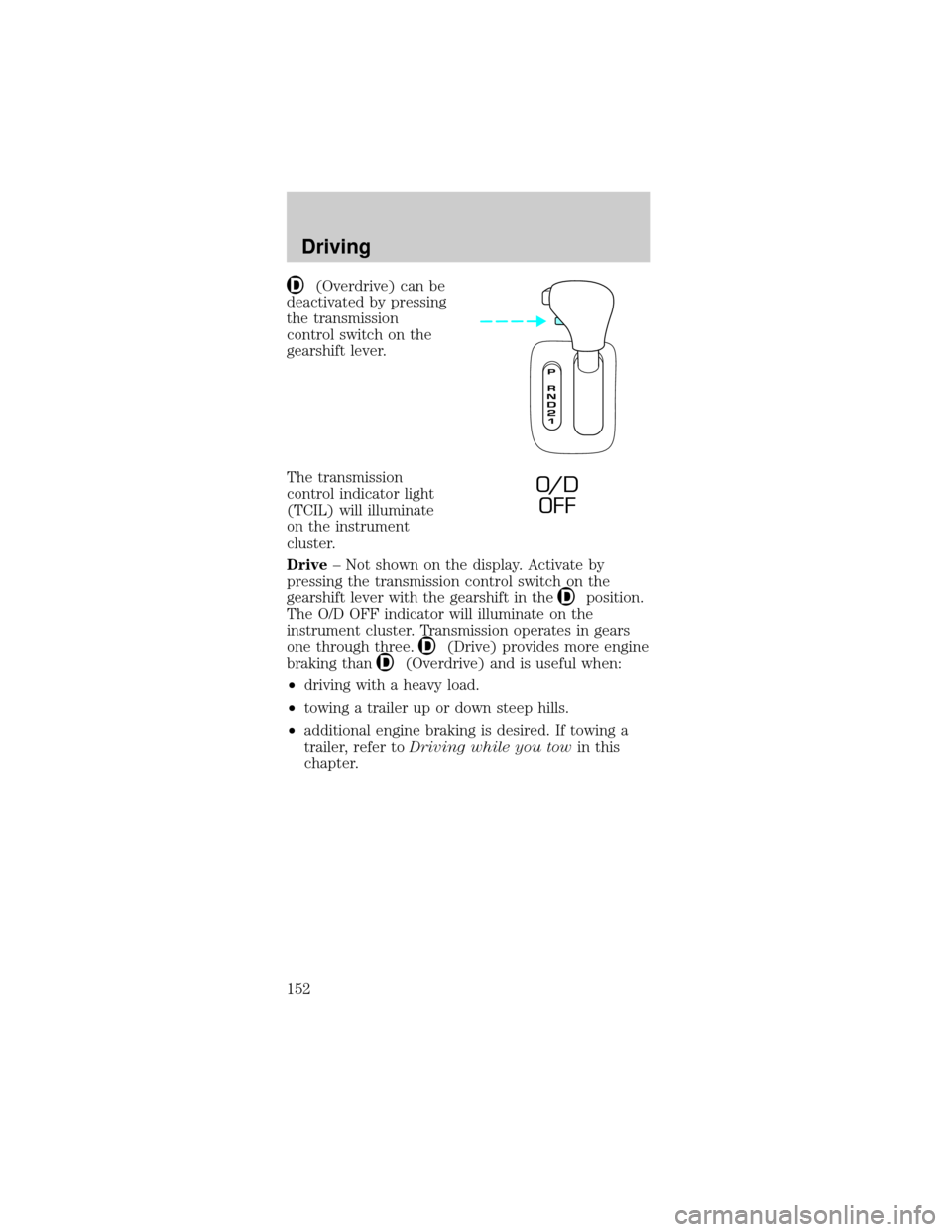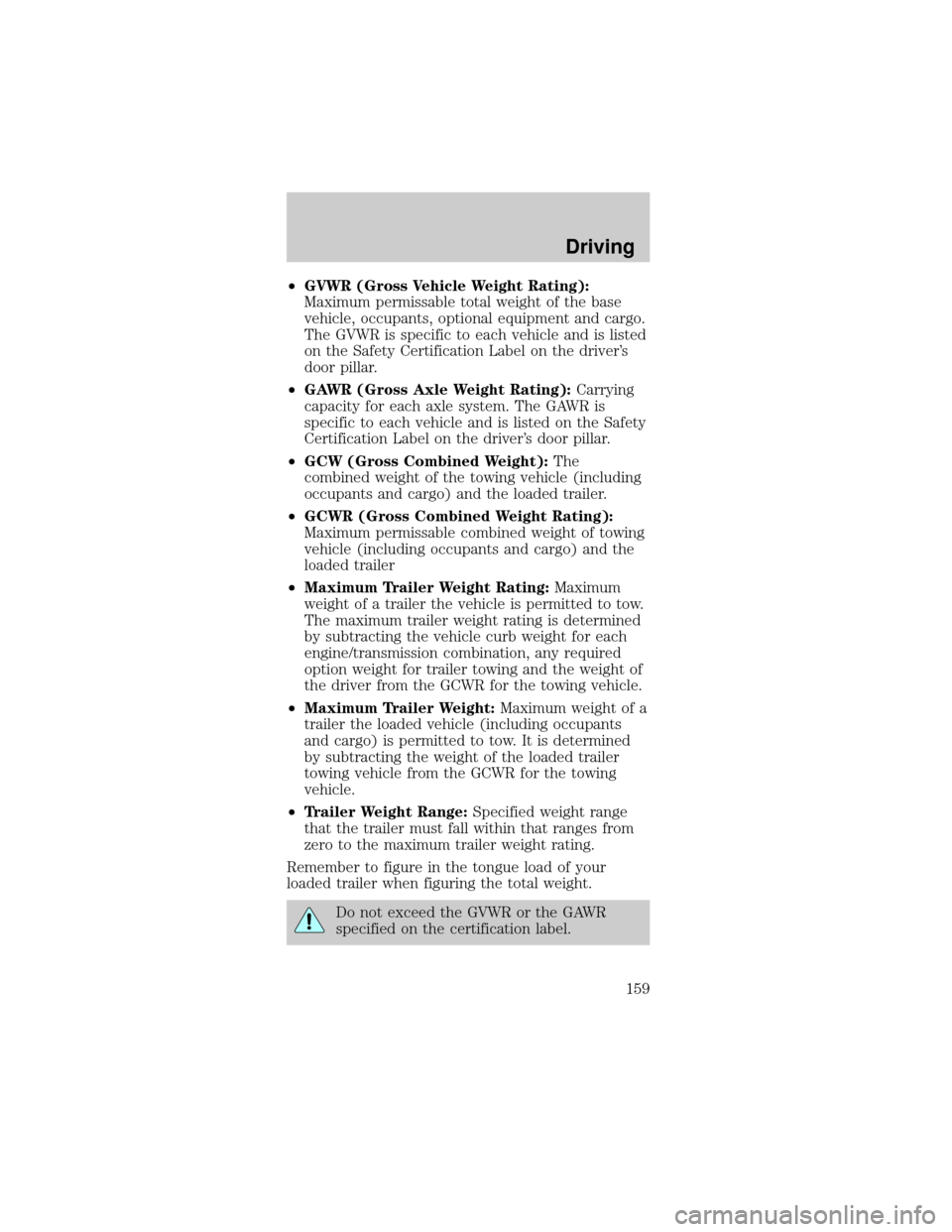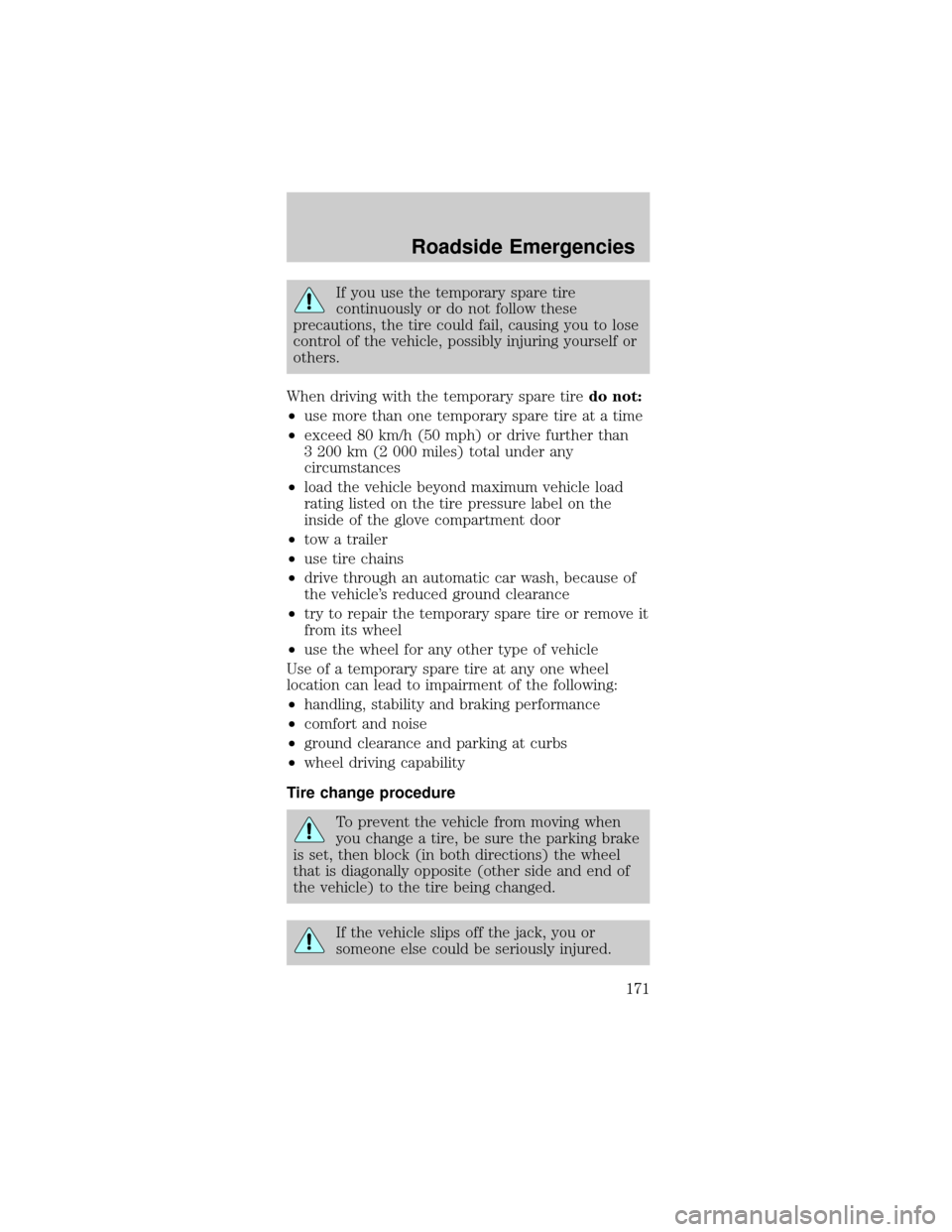trailer FORD MUSTANG 2002 4.G Owners Manual
[x] Cancel search | Manufacturer: FORD, Model Year: 2002, Model line: MUSTANG, Model: FORD MUSTANG 2002 4.GPages: 264, PDF Size: 2.56 MB
Page 2 of 264

Seating and Safety Restraints 104
Seating 104
Safety restraints 108
Air bags 120
Child restraints 126
Driving 136
Starting 136
Brakes 142
Traction control/AdvanceTrac 145
Transmission operation 148
Vehicle loading 158
Trailer towing 161
Recreational towing 161
Roadside Emergencies 162
Hazard flasher switch 163
Fuses and relays 165
Changing tires 170
Jump starting 174
Wrecker towing 179
Customer Assistance 180
The dispute settlement board 183
Utilizing the mediation/arbitration 187
Getting assistance outside the U.S. and Canada 188
Ordering additional owner's literature 189
Reporting safety defects (U.S. only) 191
Cleaning 192
Cleaning your vehicle 192
Underbody preservation 199
Table of Contents
2
Page 152 of 264

(Overdrive) can be
deactivated by pressing
the transmission
control switch on the
gearshift lever.
The transmission
control indicator light
(TCIL) will illuminate
on the instrument
cluster.
Drive± Not shown on the display. Activate by
pressing the transmission control switch on the
gearshift lever with the gearshift in the
position.
The O/D OFF indicator will illuminate on the
instrument cluster. Transmission operates in gears
one through three.
(Drive) provides more engine
braking than
(Overdrive) and is useful when:
²driving with a heavy load.
²towing a trailer up or down steep hills.
²additional engine braking is desired. If towing a
trailer, refer toDriving while you towin this
chapter.
O/ D
OFF
Driving
152
Page 159 of 264

²GVWR (Gross Vehicle Weight Rating):
Maximum permissable total weight of the base
vehicle, occupants, optional equipment and cargo.
The GVWR is specific to each vehicle and is listed
on the Safety Certification Label on the driver's
door pillar.
²GAWR (Gross Axle Weight Rating):Carrying
capacity for each axle system. The GAWR is
specific to each vehicle and is listed on the Safety
Certification Label on the driver's door pillar.
²GCW (Gross Combined Weight):The
combined weight of the towing vehicle (including
occupants and cargo) and the loaded trailer.
²GCWR (Gross Combined Weight Rating):
Maximum permissable combined weight of towing
vehicle (including occupants and cargo) and the
loaded trailer
²Maximum Trailer Weight Rating:Maximum
weight of a trailer the vehicle is permitted to tow.
The maximum trailer weight rating is determined
by subtracting the vehicle curb weight for each
engine/transmission combination, any required
option weight for trailer towing and the weight of
the driver from the GCWR for the towing vehicle.
²Maximum Trailer Weight:Maximum weight of a
trailer the loaded vehicle (including occupants
and cargo) is permitted to tow. It is determined
by subtracting the weight of the loaded trailer
towing vehicle from the GCWR for the towing
vehicle.
²Trailer Weight Range:Specified weight range
that the trailer must fall within that ranges from
zero to the maximum trailer weight rating.
Remember to figure in the tongue load of your
loaded trailer when figuring the total weight.
Do not exceed the GVWR or the GAWR
specified on the certification label.
Driving
159
Page 161 of 264

TRAILER TOWING
Your vehicle is not equipped to tow. No towing
packages are available through Ford or
Lincoln/Mercury dealers.
RECREATIONAL TOWING
(ALL WHEELS ON THE GROUND)
Follow these guidelines for your specific powertrain
combination to tow your vehicle with all four wheels
on the ground (such as behind a recreational
vehicle).
These guidelines are designed to ensure that your
transmission is not damaged due to insufficient
lubrication.
All Rear Wheel Drive (RWD) vehicles
This applies to all cars and 4x2 trucks/sport utilities
with rear wheel drive capability.
An example of recreational towing is towing your
vehicle behind a motorhome. The following
recreational towing guidelines are designed to
ensure that your transmission is not damaged.
²Place the transmission in N (Neutral).
²Maximum speed is 56 km/h (35 mph).
²Maximum distance is 80 km (50 miles).
If a distance of 80 km (50 miles) or a speed of 56
km/h (35 mph) must be exceeded, you must
disconnect the driveshaft. Ford recommends the
driveshaft be removed/installed only by a qualified
technician. See your local dealer for driveshaft
removal/installation.
Improper removal/installation of the driveshaft
can cause transmission fluid loss, damage to
the driveshaft and internal transmission
components.
Driving
161
Page 171 of 264

If you use the temporary spare tire
continuously or do not follow these
precautions, the tire could fail, causing you to lose
control of the vehicle, possibly injuring yourself or
others.
When driving with the temporary spare tiredo not:
²use more than one temporary spare tire at a time
²exceed 80 km/h (50 mph) or drive further than
3 200 km (2 000 miles) total under any
circumstances
²load the vehicle beyond maximum vehicle load
rating listed on the tire pressure label on the
inside of the glove compartment door
²tow a trailer
²use tire chains
²drive through an automatic car wash, because of
the vehicle's reduced ground clearance
²try to repair the temporary spare tire or remove it
from its wheel
²use the wheel for any other type of vehicle
Use of a temporary spare tire at any one wheel
location can lead to impairment of the following:
²handling, stability and braking performance
²comfort and noise
²ground clearance and parking at curbs
²wheel driving capability
Tire change procedure
To prevent the vehicle from moving when
you change a tire, be sure the parking brake
is set, then block (in both directions) the wheel
that is diagonally opposite (other side and end of
the vehicle) to the tire being changed.
If the vehicle slips off the jack, you or
someone else could be seriously injured.
Roadside Emergencies
171
Page 231 of 264
![FORD MUSTANG 2002 4.G Owners Manual Conditions
²Heavily loading a vehicle or towing a trailer may
reduce fuel economy at any speed.
²Carrying unnecessary weight may reduce fuel
economy (approximately 0.4 km/L [1 mpg] is lost
for every FORD MUSTANG 2002 4.G Owners Manual Conditions
²Heavily loading a vehicle or towing a trailer may
reduce fuel economy at any speed.
²Carrying unnecessary weight may reduce fuel
economy (approximately 0.4 km/L [1 mpg] is lost
for every](/img/11/5210/w960_5210-230.png)
Conditions
²Heavily loading a vehicle or towing a trailer may
reduce fuel economy at any speed.
²Carrying unnecessary weight may reduce fuel
economy (approximately 0.4 km/L [1 mpg] is lost
for every 180 kg [400 lb] of weight carried).
²Adding certain accessories to your vehicle (for
example bug deflectors, rollbars/light bars,
running boards, ski/luggage racks) may reduce
fuel economy.
²Using fuel blended with alcohol may lower fuel
economy.
²Fuel economy may decrease with lower
temperatures during the first 12±16 km
(8±10 miles) of driving.
²Driving on flat terrain offers improved fuel
economy as compared to driving on hilly terrain.
²Transmissions give their best fuel economy when
operated in the top cruise gear and with steady
pressure on the gas pedal.
²Close windows for high speed driving.
EPA window sticker
Every new vehicle should have the EPA window
sticker. Contact your dealer if the window sticker is
not supplied with your vehicle. The EPA window
sticker should be your guide for the fuel economy
comparisons with other vehicles.
It is important to note the box in the lower left
corner of the window sticker. These numbers
represent the Range of L/100 km (MPG) expected
on the vehicle under optimum conditions. Your fuel
economy may vary depending upon the method of
operation and conditions.
Maintenance and Specifications
231
Page 238 of 264

TRANSMISSION FLUID
Checking automatic transmission fluid
(if equipped)
Refer to your scheduled maintenance guide for
scheduled intervals for fluid checks and changes. Your
transmission does not consume fluid. However, the
fluid level should be checked if the transmission is not
working properly, i.e., if the transmission slips or shifts
slowly or if you notice some sign of fluid leakage.
Automatic transmission fluid expands when warmed.
To obtain an accurate fluid check, drive the vehicle
until it is at normal operating temperature
(approximately 30 km [20 miles]). If your vehicle has
been operated for an extended period at high
speeds, in city traffic during hot weather or pulling a
trailer, the vehicle should be turned off for about 30
minutes to allow fluid to cool before checking.
1. Drive the vehicle 30 km (20 miles) or until it
reaches normal operating temperature.
2. Park the vehicle on a level surface and engage the
parking brake.
3. With the parking brake engaged and your foot on
the brake pedal, start the engine and move the
gearshift lever through all of the gear ranges. Allow
sufficient time for each gear to engage.
4. Latch the gearshift lever in P (Park) and leave the
engine running.
5. Remove the dipstick, wiping it clean with a clean,
dry lint free rag. If necessary, refer toIdentifying
components in the engine compartmentin this
chapter for the location of the dipstick.
6. Install the dipstick making sure it is fully seated in
the filler tube.
7. Remove the dipstick and inspect the fluid level.
The fluid should be in the designated area for
normal operating temperature or ambient
temperature.
Maintenance and Specifications
238
Page 262 of 264

K
Keys ................. 100±102
key in ignition
chime ....................... 15
positions of the
ignition .................. 136
removing from the
ignition .................. 157
L
Lamps
bulb replacement
specifications chart.. 75
cargo lamps ............. 72
daytime running
light .......................... 71
fog lamps ................. 71
headlamps ......... 71, 76
headlamps, flash
to pass ..................... 72
instrument panel,
dimming ................... 72
interior lamps ... 74, 76
replacing
bulbs ...... 75±76, 78±80
Lane change indicator
(see Turn signal) ...... 74
Lights, warning
and indicator ............. 10
air bag ...................... 11
anti-lock brakes
(ABS) .............. 14, 144
anti-theft ................. 11
brake ........................ 15
charging system ...... 11
fuel cap light ........... 13
high beam ............... 10
low fuel .................... 13
overdrive off ............ 13
safety belt ............... 11
service engine soon.11
traction control
active ....................... 14
turn signal indicator.10
Limited slip axle
(see Traction Loc) .. 147
Load limits ............... 158
GAWR .................... 158
GVWR .................... 158
trailer towing ........ 158
Locks
doors ........................ 94
Lubricant
specifications ... 249, 251
Lug nuts, anti-theft . 174
Lumbar support,
seats ......................... 105
M
Manual
transmission ............ 154
fluid capacities ...... 247
lubricant
specifications ........ 251
reverse ................... 156
Mirrors
side view mirrors
(power) ................... 84
Motorcraft
parts ................. 227, 246
O
Octane rating .......... 225
Odometer ................... 18
Oil
(see Engine oil) ...... 206
Overdrive ........... 89, 149
Index
262
Page 264 of 264

Starting your
vehicle ...... 136±137, 139
jump starting ........ 174
Steering wheel
controls .............. 82, 85
tilting ....................... 82
T
Tachometer ............... 19
Tires ......... 170, 241±243
changing ........ 170±171
checking the
pressure ................. 243
replacing ................ 244
rotating .................. 243
snow tires and
chains .................... 245
tire grades ............. 242
treadwear .............. 242
Towing ..................... 161
recreational
towing .................... 161
trailer towing ........ 161
wrecker .................. 179
Traction control ...... 145
active light .............. 14
Traction-lok rear
axle .......................... 147
Transmission
automatic
operation ............... 148
fluid, checking
and adding
(automatic) ........... 238
fluid, checking and
adding (manual) ... 240
fluid, refill
capacities ............... 247lubricant
specifications. 249, 251
manual operation .. 154
Trip odometer ........... 19
Trunk ......................... 94
remote release .. 90, 98
Turn signal .......... 10, 74
V
Vehicle dimensions . 251
Vehicle Identification
Number (VIN) ......... 253
Vehicle loading ........ 158
Ventilating your
vehicle ...................... 141
W
Warning chimes ......... 15
Warning lights
(see Lights) ............... 10
Washer fluid ............ 206
Water, Driving
through .................... 158
Windows
power ....................... 83
Windshield washer
fluid and wipers
checking and
adding fluid ........... 206
checking and
leaning ..................... 81
operation ................. 81
replacing wiper
blades ...................... 82
Wrecker towing ....... 179
Index
264